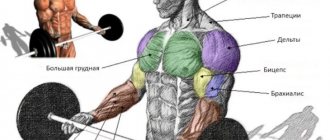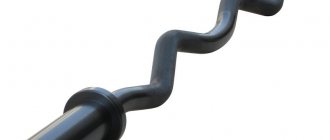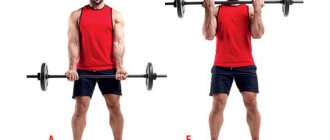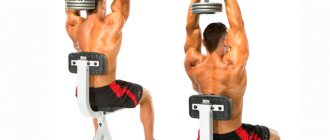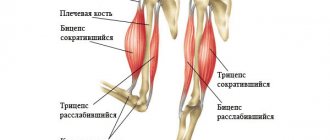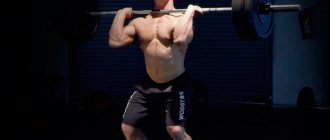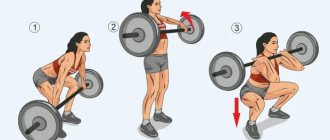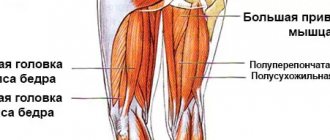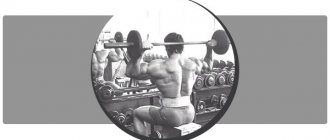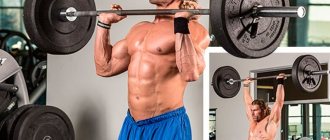What is the benefit
As already mentioned, the bar helps reduce the risk of injuries in the wrist area. When performing exercises, they turn slightly inward. This position is considered more natural and is held by stronger muscle bundles. Another nice bonus is that you can take more weight, again due to greater safety. This will not work with a straight bar - with a significant increase in weight, there will be an increase in tension in the joints and ligaments. The exercise is recommended to be used for:
- novice athletes;
- as a temporary replacement for overloading the joints with a straight bar;
- during training after injuries and injuries;
- for variety and the use of more weight.
If you are comfortable with the curved bar, you can easily move on to the straight version.
Exercises at home
Curved bars are a permanent attribute of any gym. But you can also use them at home, performing many of the exercises with a curved bar that are considered traditional today. It is important to remember that jerking when working with a curved bar is fraught with injuries no less than with other sports equipment.
The complex might look like this:
• Bent over row; • EZ-shaped rod lifting; • French press; • Overhead extension in a sitting position; • Close grip bench press.
The procedure for bent over rows is as follows: Bent over, grab the bar with an overhand grip and pull it towards your waist, tensing mainly your back muscles. When performing, the knees should be bent, the pelvis should be abducted. You can also perform biceps curls with a curved bar.
Working muscles
The exercise helps to work the biceps in isolation and increase muscle volume in this area. The load is predominantly isolated, but other muscles also work in the exercise. Lifting a barbell with a curved bar involves:
- target fibers are the biceps muscle, the biceps is the main “engine”;
- brachialis, brachioradialis – complements movement;
- stabilize the upper limb - the anterior bundles of the deltoid muscle, the upper and middle third of the trapezius, the levator scapulae muscles and the group of hand flexors.
The muscles indicated in the last paragraph experience mainly static load. But if the technique is incorrect, they begin to “help” the contraction and move along with the main muscles. Therefore, you need to monitor your sensations: tension should be felt along the anterior inner surface of the shoulder.
Execution technique
Before starting the exercise, you should decide on the weight. In this exercise, you can take a little more weight than with a straight bar. For beginners, you should adhere to the general recommendations for selecting an initial weight of % 5-7 kg for comfortable performance. The exercise can be performed standing or sitting in a Scott bench. Follow the instructions:
- stand shoulder-width apart;
- straighten your back, soften your knees;
- grab the bar with an underhand grip, fingers facing the athlete, hands slightly turned inward, thumbs covering the index fingers;
- place your arms along your body;
- bring your elbows closer to your body;
- bend your elbows slightly;
- take a breath;
- while exhaling, raise the barbell to the level of the upper third of the chest;
- hold for 1-2 seconds, feel the tension in your biceps;
- while inhaling, slowly return back;
- repeat.
Lifting and bending should be done 10-12 times, 2-3 approaches. The exercise can be done in the middle or at the beginning of a biceps set. Before performing, you should stretch your muscles well. Then you can do 5-7 training curls with less weight and move on to the main exercise.
One option is pair training. The partner insures the athlete and hands/takes the barbell. You can perform many repetitions in this mode. At the end of the set, the partner grabs the barbell and begins his lifts. The intense regime promotes muscle growth, and the competitive effect improves efficiency.
Technical nuances
When lifting the EZ bar, you should take into account the following subtleties:
- keep your head straight;
- keep your elbows away from your body;
- exclude all pushing movements and any “help” from other muscles, especially the deltoids;
- focus on trajectory and breathing;
- you should not strive to bring your arms to shoulder level;
- You cannot straighten your arms completely at the lowest point;
- when working with heavy weights, it is recommended to use special belts and place one foot forward for stability;
- rest on the heel bones;
- keep your abs and back in good shape, but do not strain;
- do the exercise slowly and without jerking;
- at the beginning of training, it is useful to lift in front of a mirror under the supervision of a trainer;
- take the barbell from a rack or from the floor in a squat, without rounding your back, especially with a large number of weights;
- increase weight gradually.
For high-quality technology, it is important to constantly monitor performance parameters:
- elbow positions;
- body condition;
- breath;
- trajectory.
You can recite these parameters to yourself while climbing.
Types of barbells
There are several types of straight chrome bar: Olympic bar for weightlifting, powerlifting and special for women. They are used for basic exercises: squats, deadlifts, barbell presses, and the like.
Olympic bar
The bushings on this plate bar rotate, which is important for weightlifting exercises that require jerking.
The neck rod has notches. Options:
- Weight – 20kg.
- 2 locks – each 2.5 kg.
- The neck diameter is 20 mm.
- Length – 2200 mm.
- Total weight with locks – 25 kg.
Olympic bar for women
This type of straight bar differs from the previous one in size and weight.
- Weight – 15 kg.
- Length – 2050 mm.
- Diameter – 25 mm.
Powerlifting bar
This bar has slight differences from the Olympic bar: the length of the bar is 2200 cm, but the diameter is 29 mm, and the weight is also 20 kg. Withstands heavy loads.
Trap neck
A hexagonal or hexagonal bar is designed for deadlifting. It replaces the Olympic bar and shifts the load to the quadriceps. By holding the bar in your hands, as opposed to a straight bar, you can avoid compressive stress on the spine.
EZ-neck
A curved bar is essential for exercising the arm muscles, especially the biceps. The special shape of the bar is able to remove excess stress from the wrists, which greatly facilitates the technique and makes it anatomically more comfortable for the joints.
- Neck length – 1200 mm.
- Weight – 6500 grams.
W-shaped neck
The curved bar is very similar to the ez-shaped bar visually and in technical characteristics, but is designed specifically for performing the French press, namely for the triceps. You can also perform biceps and forearm exercises with this bar.
Parallel grip bar
Another common name is oval. Necessary for a parallel (neutral) grip, which provides an anatomically comfortable load on the biceps and forearms. This variety can replace the two previous options for working out the arm muscles.
Universal bar (home non-professional)
These options are found in home equipment lines. A straight bar allows you to select the load for all muscle groups, but the technical characteristics must be selected depending on your physical fitness. Typically, such equipment is of poorer quality, but also costs much less.
- The length of the neck is from 1250 to 2000 cm.
- Weight – from 6 to 10 kg.
P-neck
An unusual and custom U-shaped bar that enhances the range of motion in the bench press that cannot be achieved with an Olympic bar. The special shape of the bar allows you to lower your arms lower, thereby stretching the pectoral muscles more, and this, in turn, will improve the appearance and accelerate the growth of the pectoral muscles.
- Weight: 20 kg.
- Length: 225 cm.
- Protrusion height: 35 cm.
Bar with rotating knobs
This invention is designed to provide additional supination of the biceps and pronation of the triceps, which is simply not possible with a conventional barbell lift. Rotating handles inside rings on bearings provide free rotation of the hand, as if working with dumbbells.
Hatfield Vulture
Weightlifter and powerlifter Frederick Hatfield, who invented this design, once suffered a shoulder injury, after which he could not train with a regular bar. Thanks to this, his invention was born. A bar with a shifted center of gravity provides both comfort and safety at the same time, and increases the load on the quadriceps. Special rollers do not put pressure on the shoulders, and the shift in the center of gravity does not overload the shoulder and knee joints.
What are the options
Exercises with an EZ bar can be varied:
- grip options;
- using the lower block;
- training on Larry Scott's simulator.
Using different grip methods allows you to change the load on the muscles:
- reverse grip: fingers lie on top, fingertips look down, the load shifts to the shoulder and brachioradialis muscles;
- wide grip - the wider, the more the short head of the biceps is loaded;
- narrow grip - the emphasis shifts to the long head.
The lower crossover block can be used at the beginning of biceps training. You need to attach the EZ curved handle to it. The exercise technique is no different from lifting a free barbell, but in this case the trajectory of movement is more stable. The differences in load are minor.
In Larry Scott's simulator
For a more isolated load, you can train on a Scott bench. This simulator has an inclined surface - a music stand for placing your hands. Therefore, all muscles except the biceps are practically excluded from the movement, and the load on the joints is also reduced - very useful and convenient! To do it correctly you need:
- place the EZ bar on the bar stand;
- adjust the seat height;
- sit up straight, put your feet in front of you;
- put your hands on the music stand, press your shoulders;
- grab the barbell with your fingers from below;
- make a climb and stay at the top point;
- Slowly lower down and repeat.
You need to watch your elbows - they are fixed on the bench. At the lowest point, you should also not fully straighten your arms.
Pros of use
Choosing an EZ bar for a barbell is due to a number of advantages. Among them:
- Ease of use. Most athletes prefer this type of equipment because it allows them to work with a greater load.
- Shift in emphasis. Thanks to the special shape of the rod, the muscles being worked have a slightly different, but no less accurate effect. By alternating training with a straight and curved EZ-shaped bar, you can achieve a comprehensive and even distribution of weight across different muscle groups.
- Reliable grip. Many athletes noted that due to the optimal diameter, good notch and slight inclination, holding a curved rod is much more convenient. This means that even complex exercises will be performed with minimal risk of injury.
- Safety. Exercising with a classic barbell often causes problems with the elbow and wrist joints. A curved rod, on the contrary, allows you to reduce the negative impact on them even when working at maximum amplitude and with maximum weights.
EZ barbells are permanent attributes of any fitness center. Considering the short length and optimal cost, you can buy a similar projectile for home use. By combining exercises with straight and curved rods, you will increase mass and achieve definition. You can order any required option with subsequent delivery throughout Moscow and the region.
Common mistakes
When performing the exercise, you often encounter the following errors:
- body movements during lifting;
- inclusion of other muscles of the arms and back;
- pushing and jerking;
- bent back, lowered head;
- elbows go to the side;
- too tight grip or vice versa;
- the hands are turned out - the grip on the bar should be comfortable;
- the top point is at the very line of the shoulders, the contraction is too high;
- completely straight arms below;
- high speed – increases the chances of “pushing movements” and reduces efficiency;
- incorrect leg position: too much or too little distance between the feet leads to instability;
- no coordination with breathing.
You need to monitor your movements and sensations carefully. To make the task easier, it is recommended to count: once for the rise, two or three for the delay, four for the slow movement down.
Load restrictions
Lifting the EZ bar is the safest option for working with a barbell, but there are contraindications for health reasons:
- acute injury to muscles or joints;
- gross changes in the spinal column, upper extremities;
- muscle paresis;
- arthritis in the acute stage;
- general contraindications: exacerbation of chronic diseases, acute conditions, fever, etc.);
- neuritis, neuralgia of the trunks and plexuses of the upper extremities;
- pain and swelling of the hands (a signal of inflammatory damage to the ligaments, muscles or joints).
As part of rehabilitation after injuries and getting back into shape, you should be careful. And consult with an instructor and a physical therapy doctor. Pregnancy and breastfeeding require special instructions; medical supervision is also required.
Is it possible to completely replace a straight bar with an EZ?
This question is often asked by athletes when learning about a curved barbell. It has been extensively studied to assess electrical activity in America in 2022 and concluded that using a straight bar stimulates the biceps more than an EZ bar. Therefore, it is better to use both types: straight for small and medium weights, and curved for more significant weights.
Lifting a barbell with an EZ bar helps relieve joint stress and improve training results. Increased commitment to exercise due to reduced hand discomfort. This barbell is recommended for use with heavy weights. There are different execution options depending on additional equipment and grip. The use of a curved bar does not exclude the use of a straight bar; both methods complement each other. There are also health restrictions for lifting. See you in the new blog! Subscribe to updates and invite friends!
Benefits of the ez bar biceps curl
- Thanks to the curved design, athletes can perform the exercise by focusing on the brachialis and both heads of the biceps.
- Thanks to the bends, the load is removed from the joints.
- When performing an exercise using an ez-bar, the target muscles are maximally involved in the work. Using this bar, it is very convenient to do reverse curls.
